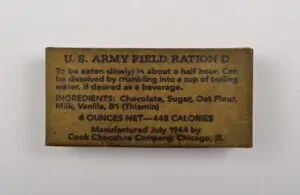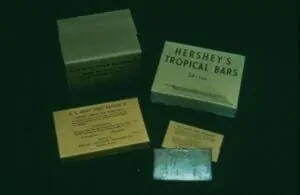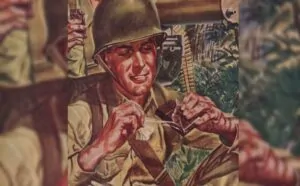How Chocolate Helped Military Soldiers
The Americans love chocolate and have a chocolate addiction. They consume it in various forms and by the tons in a year. They enjoy its unlimited taste varieties in thousands of items produced that carry visual appeal that excites their appetite. Here comes the part of history where chocolate was made a part of the US army. These military chocolate bars were specifically for soldiers.
Now being part of their lifestyle, chocolates are also used as food and ice cream toppings. The ultimate food addiction has gone right into their blood and they cannot live without it, as research studies show.
Why is Chocolate Given to Soldiers?
The American military could not ignore this lifestyle either, even in emergencies and on the borders and active fronts. The experts had put their heads together and discovered some benefits of chocolate.
Before the World War II period, American researchers proved that chocolate could be used as a morale booster by the forces besides regular food when deployed.
So they decided to replace the casual snack food with chocolate made specifically for this purpose. This could also reduce the weight carried by each soldier.
Hershey Chocolate
The job of making military chocolate, the ultimate food, more compatible with military regular adoption was entrusted to the Hershey Company. The target was to produce a chocolate bar that would not melt at high tropical temperatures and should taste a little better than boiled potatoes to make it less tempting to reduce over-use and lastly should have high energy value.
The bar size was also adjusted to fit regular uniform pockets and its weight was limited to 4 ounces. A list of ingredients including proportions by weight was instructed.

The chocolate development was termed D Ration bar. This was also termed Logan Bar, nicknamed after the Army Quartermaster, Colonel Paul Logan who pursued the idea. M/S Hershey was too pleased to undertake the project with their chief chemist developing a workable formula to fulfill the limitations.
D Ration Bar
The initial experimental production was in 1937. Thereafter, the Hershey Company had to build a new production plant to suit the precise formula and mass produce this temperature-resistant chocolate.
Finally, a hard block of brown chocolate was produced that could resist 120 degrees Fahrenheit and wrapped in aluminum foil. It provided the soldier with 1800 calories as recommended each day. The trial order of about 100’000 D Ration Bars was field tested in Texas, Panama, and even by Admiral Byrd’s third Antarctic expedition. It was found satisfactory except for the intended awkward taste. The military started buying periodically thereafter.

The Pearl Harbor was attacked by the Japanese, thus starting the World War II. Hershey Company was asked to make the chocolate packing poison gas proof. The company covered the smaller packing with anti-gas coating and also coated the master carton for safety.
During the massive use, unfavorable comments arose against the chocolate’s somewhat bitter taste. Also that it was too hard for many to break their teeth and had to be sliced by the knife before eating.
Also many threw it instead of consuming it, being too unpalatable for quite a few. This massive detest could not be ignored by senior officers.
The Tropical Bar
The Army contacted the Hershey Company to produce a better-flavored chocolate bar that could resist heat but should be easily chewable instead of the present hard block needing slicing. This was now to be suitable for the Pacific region temperatures.
The company undertook the assignment, revised the formula through experiments, and was successful in producing a better product.

The tropical bar was termed K ration. The packaging was 1 and 2 ounces per pack in 1943. From 1945 the 4-ounce D ration bar size was also restored. The changes made in the formula followed the pre-condition that the taste should not be too tempting.
Although the outward resemblance was normal still the soldiers found it unappetizing and reportedly often traded off with the locals for more tasty eatables. Later it was found that persons with “dysentery” did tolerate this “dysentery ration”.
The formula was again changed in 1957 to make it more tasty and palatable by replacing oat flour with milk powder and vanilla flavors, besides other content changes.
During the war period from 1940 to 1945, over 3 billion D ration bars were made, averaging about 24 million a week. The company was decorated with the Army-Navy ‘E’ Award for Excellence for performance better than expected.
This Award was repeated 5 times for mass-producing this ultimate chocolate. The Tropical Bar was used last in the Vietnam War and then discontinued. However, it was used by Apollo 15 crew in 1971.
The Congo Bar

The U.S. Army Natick Labs researched a new high-temperature chocolate “Congo Bar” that tasted better and resisted heat up to 140 degrees Fahrenheit.
The military operations “Desert storm” and “Desert Shield” were supplied with this new chocolate bar. The “Desert Bar” received somewhat mixed acceptances and remained in limited use.
After the Army operations ended the Production was discontinued. Limited stocks went to the local market as “Novelty” till supplies were exhausted.
Take Aways
In conclusion, chocolate has firmly entrenched itself as an integral part of American culture and lifestyle. Americans are renowned for their deep love and addiction to this delectable treat.
During World War II, American researchers recognized the morale-boosting potential of chocolate for soldiers. They tasked the Hershey Company with creating a chocolate bar specifically designed for military use.
The result was the D Ration bar. It was engineered to withstand high temperatures, provide ample energy, and fit conveniently in a soldier’s pocket. Although the taste was less than appealing to many, this innovative chocolate bar played a crucial role in nourishing troops during wartime.
Over the years, the military adapted to evolving preferences, leading to the creation of the K ration and the Congo Bar. Each was designed to meet the specific needs of soldiers.
Now in the modern era, there are a number of most finest chocolates in the world. Almost all the chocolates are available in the US because of the high demand.
In the end, the enduring relationship between Americans and chocolate persists. Chocolate was a source of comfort in the face of diversity. It remains a crucial part of the American lifestyle in its many forms. Chocolates are cherished for their ability to provide a moment of solace and delight in times of both peace and conflict.

just good for info, but what the benefit, if cannot get it from market.
Great!Thanks!
Does writing these blogs make you any money? It seems like it would take a long time to write these. I hope all the hard work pays off for you.
Not many people would say this. Youve got some guts. I will say this, though. If you dont want to alienate any readers, youre gonna have to stop generalising so much. Maybe you should try seeing both sides of this issue instead of assuming that yours is the only valid opinion. Id still read it, I like the way you write. But I can see some people getting upset.